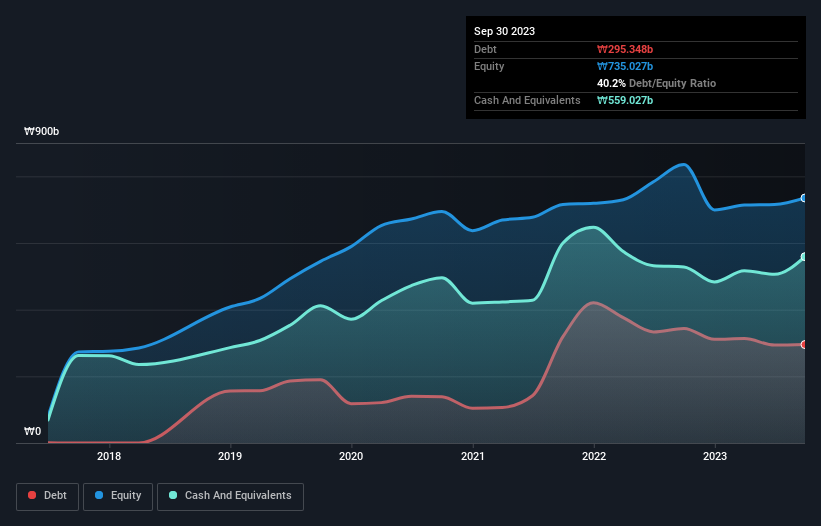- South Korea
- /
- Entertainment
- /
- KOSDAQ:A263750
Health Check: How Prudently Does Pearl Abyss (KOSDAQ:263750) Use Debt?
David Iben put it well when he said, 'Volatility is not a risk we care about. What we care about is avoiding the permanent loss of capital.' When we think about how risky a company is, we always like to look at its use of debt, since debt overload can lead to ruin. As with many other companies Pearl Abyss Corp. (KOSDAQ:263750) makes use of debt. But is this debt a concern to shareholders?
What Risk Does Debt Bring?
Debt and other liabilities become risky for a business when it cannot easily fulfill those obligations, either with free cash flow or by raising capital at an attractive price. In the worst case scenario, a company can go bankrupt if it cannot pay its creditors. While that is not too common, we often do see indebted companies permanently diluting shareholders because lenders force them to raise capital at a distressed price. Of course, debt can be an important tool in businesses, particularly capital heavy businesses. When we examine debt levels, we first consider both cash and debt levels, together.
See our latest analysis for Pearl Abyss
What Is Pearl Abyss's Net Debt?
The image below, which you can click on for greater detail, shows that Pearl Abyss had debt of ₩295.3b at the end of September 2023, a reduction from ₩343.7b over a year. But it also has ₩559.0b in cash to offset that, meaning it has ₩263.7b net cash.

A Look At Pearl Abyss' Liabilities
The latest balance sheet data shows that Pearl Abyss had liabilities of ₩302.4b due within a year, and liabilities of ₩256.9b falling due after that. Offsetting this, it had ₩559.0b in cash and ₩68.8b in receivables that were due within 12 months. So it actually has ₩68.5b more liquid assets than total liabilities.
This surplus suggests that Pearl Abyss has a conservative balance sheet, and could probably eliminate its debt without much difficulty. Simply put, the fact that Pearl Abyss has more cash than debt is arguably a good indication that it can manage its debt safely. There's no doubt that we learn most about debt from the balance sheet. But it is future earnings, more than anything, that will determine Pearl Abyss's ability to maintain a healthy balance sheet going forward. So if you want to see what the professionals think, you might find this free report on analyst profit forecasts to be interesting.
Over 12 months, Pearl Abyss made a loss at the EBIT level, and saw its revenue drop to ₩352b, which is a fall of 12%. That's not what we would hope to see.
So How Risky Is Pearl Abyss?
While Pearl Abyss lost money on an earnings before interest and tax (EBIT) level, it actually generated positive free cash flow ₩58b. So although it is loss-making, it doesn't seem to have too much near-term balance sheet risk, keeping in mind the net cash. With mediocre revenue growth in the last year, we're don't find the investment opportunity particularly compelling. When we look at a riskier company, we like to check how their profits (or losses) are trending over time. Today, we're providing readers this interactive graph showing how Pearl Abyss's profit, revenue, and operating cashflow have changed over the last few years.
If you're interested in investing in businesses that can grow profits without the burden of debt, then check out this free list of growing businesses that have net cash on the balance sheet.
New: Manage All Your Stock Portfolios in One Place
We've created the ultimate portfolio companion for stock investors, and it's free.
• Connect an unlimited number of Portfolios and see your total in one currency
• Be alerted to new Warning Signs or Risks via email or mobile
• Track the Fair Value of your stocks
Have feedback on this article? Concerned about the content? Get in touch with us directly. Alternatively, email editorial-team (at) simplywallst.com.
This article by Simply Wall St is general in nature. We provide commentary based on historical data and analyst forecasts only using an unbiased methodology and our articles are not intended to be financial advice. It does not constitute a recommendation to buy or sell any stock, and does not take account of your objectives, or your financial situation. We aim to bring you long-term focused analysis driven by fundamental data. Note that our analysis may not factor in the latest price-sensitive company announcements or qualitative material. Simply Wall St has no position in any stocks mentioned.
About KOSDAQ:A263750
Reasonable growth potential with adequate balance sheet.
Similar Companies
Market Insights
Community Narratives



